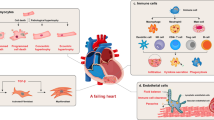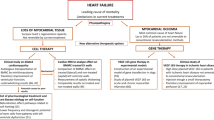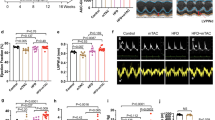Abstract
Although progress in conventional treatments is making steady and incremental gains to reduce mortality associated with heart failure (HF), there remains a need to explore potentially new therapeutic approaches. HF induced by different etiologies such as coronary artery disease, hypertension, diabetes, infection or inflammation results generally in calcium cycling dysregulation at the myocyte level. Recent advances in understanding of the molecular basis of these calcium cycling abnormalities, together with the evolution of increasingly efficient gene transfer technology, has placed HF within the reach of gene-based therapy. Furthermore, the recent successful completion of a phase 2 trial targeting the sarcoplasmic reticulum calcium pump ushers in a new era for gene therapy for the treatment of HF.
This is a preview of subscription content, access via your institution
Access options
Subscribe to this journal
Receive 12 print issues and online access
$259.00 per year
only $21.58 per issue
Buy this article
- Purchase on Springer Link
- Instant access to full article PDF
Prices may be subject to local taxes which are calculated during checkout
Similar content being viewed by others
References
Lloyd-Jones D, Adams RJ, Brown TM, Carnethon M, Dai S, De Simone G et al. Heart disease and stroke statistics--2010 update: a report from the American Heart Association. Circulation 2010; 121: e46–e215.
Lloyd-Jones D, Adams R, Carnethon M, De Simone G, Ferguson TB, Flegal K et al. Heart disease and stroke statistics--2009 update: a report from the American Heart Association Statistics Committee and Stroke Statistics Subcommittee. Circulation 2009; 119: 480–486.
Roger VL, Go AS, Lloyd-Jones DM, Adams RJ, Berry JD, Brown TM et al. Heart disease and stroke statistics--2011 update: a report from the American Heart Association. Circulation 2011; 123: e18–e209.
Stevenson LW . Inotropic therapy for heart failure. N Engl J Med 1998; 339: 1848–1850.
Stevenson LW . Clinical use of inotropic therapy for heart failure: looking backward or forward? Part II: chronic inotropic therapy. Circulation 2003; 108: 492–497.
Stevenson LW . Challenges for the basis of practice in heart failure. Circ Heart Fail 2008; 1: 81–83.
Stevenson LW, Couper G, Natterson B, Fonarow G, Hamilton MA, Woo M et al. Target heart failure populations for newer therapies. Circulation 1995; 92 (9 Suppl): II174–II181.
Stevenson LW, Miller LW, Desvigne-Nickens P, Ascheim DD, Parides MK, Renlund DG et al. Left ventricular assist device as destination for patients undergoing intravenous inotropic therapy: a subset analysis from REMATCH (Randomized Evaluation of Mechanical Assistance in Treatment of Chronic Heart Failure). Circulation 2004; 110: 975–981.
Gwathmey JK, Slawsky MT, Hajjar RJ, Briggs GM, Morgan JP . Role of intracellular calcium handling in force-interval relationships of human ventricular myocardium. J Clin Invest 1990; 85: 1599–5613.
Schmidt U, Hajjar RJ, Helm PA, Kim CS, Doye AA, Gwathmey JK . Contribution of abnormal sarcoplasmic reticulum ATPase activity to systolic and diastolic dysfunction in human heart failure. J Mol Cell Cardiol 1998; 30: 1929–1237.
Hasenfuss G, Reinecke H, Studer R, Meyer M, Pieske B, Holtz J et al. Relation between myocardial function and expression of sarcoplasmic reticulum Ca(2+)-ATPase in failing and nonfailing human myocardium. Circ Res 1994; 75: 434–442.
Hasenfuss G, Reinecke H, Studer R, Pieske B, Meyer M, Drexler H et al. Calcium cycling proteins and force-frequency relationship in heart failure. Basic Res Cardiol 1996; 91 (Suppl 2): 17–22.
Hasenfuss G, Schillinger W, Lehnart SE, Preuss M, Pieske B, Maier LS et al. Relationship between Na+-Ca2+-exchanger protein levels and diastolic function of failing human myocardium. Circulation 1999; 99: 641–648.
Tilemann L, Ishikawa K, Weber T, Hajjar RJ . Gene therapy for heart failure. Circ Res 2012; 110: 777–793.
Kawase Y, Ladage D, Hajjar RJ . Rescuing the failing heart by targeted gene transfer. J Am Coll Cardiol 2011; 57: 1169–1180.
Jaski BE, Jessup ML, Mancini DM, Cappola TP, Pauly DF, Greenberg B et al. Calcium upregulation by percutaneous administration of gene therapy in cardiac disease (CUPID Trial), a first-in-human phase 1/2 clinical trial. J Card Fail 2009; 15: 171–181.
Jessup M, Greenberg B, Mancini D, Cappola T, Pauly DF, Jaski B et al. Calcium Upregulation by Percutaneous Administration of Gene Therapy in Cardiac Disease (CUPID): a phase 2 trial of intracoronary gene therapy of sarcoplasmic reticulum Ca2+-ATPase in patients with advanced heart failure. Circulation 2011; 124: 304–313.
Kawase Y, Ly HQ, Prunier F, Lebeche D, Shi Y, Jin H et al. Reversal of cardiac dysfunction after long-term expression of SERCA2a by gene transfer in a pre-clinical model of heart failure. J Am Coll Cardiol 2008; 51: 1112–1119.
Ladage D, Turnbull IC, Ishikawa K, Takewa Y, Rapti K, Morel C et al. Delivery of gel foam-enabled cells and vectors into the pericardial space using a percutaneous approach in a porcine model. Gene Therapy 2011; 18: 979–985.
Byrne MJ, Power JM, Preovolos A, Mariani JA, Hajjar RJ, Kaye DM . Recirculating cardiac delivery of AAV2/1SERCA2a improves myocardial function in an experimental model of heart failure in large animals. Gene Therapy 2008; 15: 1550–1557.
Kaye DM, Preovolos A, Marshall T, Byrne M, Hoshijima M, Hajjar R et al. Percutaneous cardiac recirculation-mediated gene transfer of an inhibitory phospholamban peptide reverses advanced heart failure in large animals. J Am Coll Cardiol 2007; 50: 253–260.
Flotte TR, Solow R, Owens RA, Afione S, Zeitlin PL, Carter BJ . Gene expression from adeno-associated virus vectors in airway epithelial cells. Am J Respir Cell Mol Biol 1992; 7: 349–356.
Gao G, Alvira MR, Somanathan S, Lu Y, Vandenberghe LH, Rux JJ et al. Adeno-associated viruses undergo substantial evolution in primates during natural infections. Proc Natl Acad Sci USA 2003; 100: 6081–6086.
Gao G, Lu Y, Calcedo R, Grant RL, Bell P, Wang L et al. Biology of AAV serotype vectors in liver-directed gene transfer to nonhuman primates. Mol Ther 2006; 13: 77–87.
Gao G, Vandenberghe LH, Wilson JM . New recombinant serotypes of AAV vectors. Curr Gene Ther 2005; 5: 285–297.
Hajjar RJ, Zsebo K . AAV vectors and cardiovascular disease: targeting TNF receptor in the heart: clue to way forward with AAV? Gene Therapy 2007; 14: 1611–1612.
Bell CL, Vandenberghe LH, Bell P, Limberis MP, Gao GP, Van Vliet K et al. The AAV9 receptor and its modification to improve in vivo lung gene transfer in mice. J Clin Invest 2011; 121: 2427–2435.
Carter BJ . Adeno-associated virus vectors in clinical trials. Hum Gene Ther 2005; 16: 541–550.
McCarty DM, Fu H, Monahan PE, Toulson CE, Naik P, Samulski RJ . Adeno-associated virus terminal repeat (TR) mutant generates self-complementary vectors to overcome the rate-limiting step to transduction in vivo. Gene Therapy 2003; 10: 2112–2118.
Calcedo R, Vandenberghe LH, Gao G, Lin J, Wilson JM . Worldwide epidemiology of neutralizing antibodies to adeno-associated viruses. J Infect Dis 2009; 199: 381–390.
Yang Y, Li Q, Ertl HC, Wilson JM . Cellular and humoral immune responses to viral antigens create barriers to lung-directed gene therapy with recombinant adenoviruses. J Virol 1995; 69: 2004–2015.
Bers DM . Cardiac excitation-contraction coupling. Nature 2002; 415: 198–205.
Hajjar RJ, Kang JX, Gwathmey JK, Rosenzweig A . Physiological effects of adenoviral gene transfer of sarcoplasmic reticulum calcium ATPase in isolated rat myocytes. Circulation 1997; 95: 423–429.
Hajjar RJ, Schmidt U, Matsui T, Guerrero JL, Lee KH, Gwathmey JK et al. Modulation of ventricular function through gene transfer in vivo. Proc Natl Acad Sci USA 1998; 95: 5251–5256.
Loukianov E, Ji Y, Grupp IL, Kirkpatrick DL, Baker DL, Loukianova T et al. Enhanced myocardial contractility and increased Ca2+ transport function in transgenic hearts expressing the fast-twitch skeletal muscle sarcoplasmic reticulum Ca2+-ATPase. Circ Res 1998; 83: 889–897.
Mork HK, Sjaastad I, Sande JB, Periasamy M, Sejersted OM, Louch WE . Increased cardiomyocyte function and Ca2+ transients in mice during early congestive heart failure. J Mol Cell Cardiol 2007; 43: 177–186.
Periasamy M, Reed TD, Liu LH, Ji Y, Loukianov E, Paul RJ et al. Impaired cardiac performance in heterozygous mice with a null mutation in the sarco(endo)plasmic reticulum Ca2+-ATPase isoform 2 (SERCA2) gene. J Biol Chem 1999; 274: 2556–2562.
Schultz Jel J, Glascock BJ, Witt SA, Nieman ML, Nattamai KJ, Liu LH et al. Accelerated onset of heart failure in mice during pressure overload with chronically decreased SERCA2 calcium pump activity. Am J Physiol Heart Circ Physiol 2004; 286: H1146–H1153.
Hajjar RJ, Schmidt U, Kang JX, Matsui T, Rosenzweig A . Adenoviral gene transfer of phospholamban in isolated rat cardiomyocytes. Rescue effects by concomitant gene transfer of sarcoplasmic reticulum Ca(2+)-ATPase. Circ Res 1997; 81: 145–153.
del Monte F, Harding SE, Schmidt U, Matsui T, Kang ZB, Dec GW et al. Restoration of contractile function in isolated cardiomyocytes from failing human hearts by gene transfer of SERCA2a. Circulation 1999; 100: 2308–2311.
Miyamoto MI, del Monte F, Schmidt U, DiSalvo TS, Kang ZB, Matsui T et al. Adenoviral gene transfer of SERCA2a improves left-ventricular function in aortic-banded rats in transition to heart failure. Proc Natl Acad Sci USA 2000; 97: 793–798.
del Monte F, Williams E, Lebeche D, Schmidt U, Rosenzweig A, Gwathmey JK et al. Improvement in survival and cardiac metabolism after gene transfer of sarcoplasmic reticulum Ca(2+)-ATPase in a rat model of heart failure. Circulation 2001; 104: 1424–1429.
Sakata S, Lebeche D, Sakata N, Sakata Y, Chemaly ER, Liang LF et al. Restoration of mechanical and energetic function in failing aortic-banded rat hearts by gene transfer of calcium cycling proteins. J Mol Cell Cardiol 2007; 42: 852–861.
Davia K, Bernobich E, Ranu HK, del Monte F, Terracciano CM, MacLeod KT et al. SERCA2A overexpression decreases the incidence of aftercontractions in adult rabbit ventricular myocytes. J Mol Cell Cardiol 2001; 33: 1005–1015.
del Monte F, Lebeche D, Guerrero JL, Tsuji T, Doye AA, Gwathmey JK et al. Abrogation of ventricular arrhythmias in a model of ischemia and reperfusion by targeting myocardial calcium cycling. Proc Natl Acad Sci USA 2004; 101: 5622–5627.
Prunier F, Kawase Y, Gianni D, Scapin C, Danik SB, Ellinor PT et al. Prevention of ventricular arrhythmias with sarcoplasmic reticulum Ca2+ ATPase pump overexpression in a porcine model of ischemia reperfusion. Circulation 2008; 118: 614–624.
Cutler MJ, Wan X, Laurita KR, Hajjar RJ, Rosenbaum DS . Targeted SERCA2a gene expression identifies molecular mechanism and therapeutic target for arrhythmogenic cardiac alternans. Circ Arrhythm Electrophysiol 2009; 2: 686–694.
Del Monte F, Dalal R, Tabchy A, Couget J, Bloch KD, Peterson R et al. Transcriptional changes following restoration of SERCA2a levels in failing rat hearts. FASEB J 2004; 18: 1474–1476.
Pleger ST, Most P, Boucher M, Soltys S, Chuprun JK, Pleger W et al. Stable myocardial-specific AAV6-S100A1 gene therapy results in chronic functional heart failure rescue. Circulation 2007; 115: 2506–2515.
Hajjar RJ, Zsebo K, Deckelbaum L, Thompson C, Rudy J, Yaroshinsky A et al. Design of a phase 1/2 trial of intracoronary administration of AAV1/SERCA2a in patients with heart failure. J Card Fail 2008; 14: 355–367.
Jessup M, Greenberg B, Mancini D, Cappola T, Pauly DF, Jaski B et al. Calcium Upregulation by Percutaneous Administration of Gene Therapy in Cardiac Disease (CUPID): a phase 2 trial of intracoronary gene therapy of sarcoplasmic reticulum Ca2+-ATPase in patients with advanced heart failure. Circulation 2011; 124: 304–313.
Suckau L, Fechner H, Chemaly E, Krohn S, Hadri L, Kockskamper J et al. Long-term cardiac-targeted RNA interference for the treatment of heart failure restores cardiac function and reduces pathological hypertrophy. Circulation 2009; 119: 1241–1252.
Acknowledgements
This work is supported by Leducq Foundation through the CAERUS network (RJH), NIH HL093183, HL088434, HL071763, HL080498, HL083156 and HL100396 (RJH).
Author information
Authors and Affiliations
Corresponding author
Ethics declarations
Competing interests
RJH is a scientific co-founder of CELLADON corporation, which is planning to commercializing AAV1.SERCA2a for the treatment of heart failure.
Rights and permissions
About this article
Cite this article
Hulot, JS., Senyei, G. & Hajjar, R. Sarcoplasmic reticulum and calcium cycling targeting by gene therapy. Gene Ther 19, 596–599 (2012). https://doi.org/10.1038/gt.2012.34
Received:
Revised:
Accepted:
Published:
Issue Date:
DOI: https://doi.org/10.1038/gt.2012.34
Keywords
This article is cited by
-
Integrin-linked kinase mediates force transduction in cardiomyocytes by modulating SERCA2a/PLN function
Nature Communications (2014)



